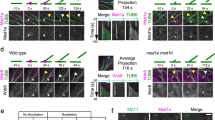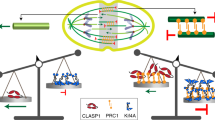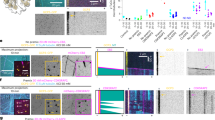Abstract
Rho-GTPase stabilizes microtubules that are oriented towards the leading edge in serum-starved 3T3 fibroblasts through an unknown mechanism. We used a Rho-effector domain screen to identify mDia as a downstream Rho effector involved in microtubule stabilization. Constitutively active mDia or activation of endogenous mDia with the mDia-autoinhibitory domain stimulated the formation of stable microtubules that were capped and oriented towards the wound edge. mDia co-localized with stable microtubules when overexpressed and associated with microtubules in vitro. Rho kinase was not necessary for the formation of stable microtubules. Our results show that mDia is sufficient to generate and orient stable microtubules, and indicate that Dia-related formins are part of a conserved pathway that regulates the dynamics of microtubule ends.
This is a preview of subscription content, access via your institution
Access options
Subscribe to this journal
Receive 12 print issues and online access
$209.00 per year
only $17.42 per issue
Buy this article
- Purchase on Springer Link
- Instant access to full article PDF
Prices may be subject to local taxes which are calculated during checkout







Similar content being viewed by others
References
Vasiliev, J. M. & Gelfand, I. M. Effects of colcemid on morphogenetic processes and locomotion in fibroblasts. Cold Spring Harbor Conf. Cell Proliferation 3, 279–304 (1976).
Gundersen, G. G. & Cook, T. A. Microtubules and signal transduction. Curr. Opin. Cell Biol. 11, 81–94 (1999).
Cole, N. B. & Lippincott-Schwartz, J. Organization of organelles and membrane traffic by microtubules. Curr. Opin. Cell Biol. 7, 55–64 (1995).
Saxton, W. M. et al. Tubulin dynamics in cultured mammalian cells. J. Cell Biol. 99, 2175–2186 (1984).
Schulze, E. & Kirschner, M. Microtubule dynamics in interphase cells. J. Cell Biol. 102, 1020–1031 (1986).
Webster, D. R., Gundersen, G. G., Bulinski, J. C. & Borisy, G. G. Differential turnover of tyrosinated and detyrosinated microtubules. Proc. Natl Acad. Sci. USA 84, 9040–9044 (1987).
Bulinski, J. C. & Gundersen, G. G. Stabilization and post-translational modification of microtubules during cellular morphogenesis. Bioessays 13, 285–293 (1991).
Idriss, H. Man to trypanosome: the tubulin tyrosination/detyrosination cycle revisited. Cell Motil. Cytoskeleton 45, 173–184 (2000).
Gundersen, G. G., Kalnoski, M. H. & Bulinski, J. C. Distinct populations of microtubules: tyrosinated and nontyrosinated α-tubulin are distributed differently in vivo. Cell 38, 779–789 (1984).
Gurland, G. & Gundersen, G. G. Stable, detyrosinated microtubules function to localize vimentin intermediate filaments in fibroblasts. J. Cell Biol. 131, 1275–1290 (1995).
Kreitzer, G., Liao, G. & Gundersen, G. G. Detyrosination of tubulin regulates the interaction of intermediate filaments with microtubules in vivo via a kinesin-dependent mechanism. Mol. Biol. Cell 10, 1105–1118 (1999).
Liao, G. & Gundersen, G. G. Kinesin is a candidate for cross-bridging microtubules and intermediate filaments. Selective binding of kinesin to detyrosinated tubulin and vimentin. J. Biol. Chem. 273, 9797–9803 (1998).
Larcher, J. C., Boucher, D., Lazereg, S., Gros, F. & Denoulet, P. Interaction of kinesin motor domains with α- and β-tubulin subunits at a Tau-independent binding site. J. Biol. Chem. 271, 22117–22124 (1996).
Khawaja, S., Gundersen, G. G. & Bulinski, J. C. Enhanced stability of microtubules enriched in detyrosinated tubulin is not a direct function of detyrosination level. J. Cell Biol. 106, 141–149 (1988).
Webster, D. R., Wehland, J., Weber, K. & Borisy, G. G. Detyrosination of α-tubulin does not stabilize microtubules in vivo. J. Cell Biol. 111, 113–122 (1990); erratum: J. Cell Biol. 111, 1325–1326 (1990).
Cook, T. A., Nagasaki, T. & Gundersen, G. G. Rho guanosine triphosphatase mediates the selective stabilization of microtubules induced by lysophosphatidic acid. J. Cell Biol. 141, 175–185 (1998).
Gundersen, G. G., Kim, I. & Chapin, C. J. Induction of stable microtubules in 3T3 fibroblasts by TGF-β and serum. J. Cell Sci. 107, 645–659 (1994).
Nagasaki, T. & Gundersen, G. G. Depletion of lysophosphatidic acid triggers a loss of oriented detyrosinated microtubules in motile fibroblasts. J. Cell Sci. 109, 2461–2469 (1996).
Best, A., Ahmed, S., Kozma, R. & Lim, L. The Ras-related GTPase Rac1 binds tubulin. J. Biol. Chem. 271, 3756–3762 (1996).
Watanabe, N. et al. p140mDia, a mammalian homolog of Drosophila diaphanous, is a target protein for Rho small GTPase and is a ligand for profilin. Embo J. 16, 3044–3056 (1997).
Alberts, A. S., Bouquin, N., Johnston, L. H. & Treisman, R. Analysis of RhoA-binding proteins reveals an interaction domain conserved in heterotrimeric G-protein β-subunits and the yeast response regulator protein Skn7. J. Biol. Chem. 273, 8616–8622 (1998).
Castrillon, D. H. & Wasserman, S. A. Diaphanous is required for cytokinesis in Drosophila and shares domains of similarity with the products of the limb deformity gene. Development 120, 3367–3377 (1994).
Harris, S. D., Hamer, L., Sharpless, K. E. & Hamer, J. E. The Aspergillus nidulans sepA gene encodes an FH1/2 protein involved in cytokinesis and the maintenance of cellular polarity. Embo J. 16, 3474–3483 (1997).
Zahner, J. E., Harkins, H. A. & Pringle, J. R. Genetic analysis of the bipolar pattern of bud site selection in the yeast Saccharomyces cerevisiae. Mol. Cell Biol. 16, 1857–1870 (1996).
Lee, L., Klee, S. K., Evangelista, M., Boone, C. & Pellman, D. Control of mitotic spindle position by the Saccharomyces cerevisiae formin Bni1p. J. Cell Biol. 144, 947–961 (1999).
Adames, N. R. & Cooper, J. A. Microtubule interactions with the cell cortex causing nuclear movements in Saccharomyces cerevisiae. J. Cell Biol. 149, 863–874 (2000).
Ishizaki, T. et al. Coordination of microtubules and the actin cytoskeleton by the Rho effector mDia1. Nature Cell Biol. 3, 8–14 (2001).
Tominaga, T. et al. Diaphanous-related formins bridge Rho GTPase and Src tyrosine kinase signaling. Mol. Cell 5, 13–25 (2000).
Bione, S. et al. A human homologue of the Drosophila melanogaster diaphanous gene is disrupted in a patient with premature ovarian failure: evidence for conserved function in oogenesis and implications for human sterility. Am. J. Hum. Genet. 62, 533–541 (1998).
Lynch, E. D. et al. Nonsyndromic deafness DFNA1 associated with mutation of a human homolog of the Drosophila gene diaphanous. Science 278, 1315–1318 (1997).
Sahai, E., Alberts, A. S. & Treisman, R. RhoA effector mutants reveal distinct effector pathways for cytoskeletal reorganization, SRF activation and transformation. Embo J. 17, 1350–1361 (1998).
Wasserman, S. FH proteins as cytoskeletal organizers. Trends Cell Biol. 8, 111–115 (1998).
Watanabe, N., Kato, T., Fujita, A., Ishizaki, T. & Narumiya, S. Cooperation between mDia1 and ROCK in Rho-induced actin reorganization. Nature Cell Biol. 1, 136–143 (1999).
Nakano, K. et al. Distinct actions and cooperative roles of ROCK and mDia in Rho small G protein-induced reorganization of the actin cytoskeleton in Madin-Darby canine kidney cells. Mol. Biol. Cell 10, 2481–2491 (1999).
Tominaga, T., Ishizaki, T., Narumiya, S. & Barber, D. L. p160ROCK mediates RhoA activation of Na-H exchange. Embo J. 17, 4712–4722 (1998).
Alberts, A. S. Identification of a carboxy-terminal diaphanous-related formin homology protein autoregulatory domain. J. Biol. Chem. (2001).
Gotlieb, A. I., May, L. M., Subrahmanyan, L. & Kalnins, V. I. Distribution of microtubule organizing centres in migrating sheets of endothelial cells. J. Cell Biol. 91, 589–594 (1981).
Gundersen, G. G. & Bulinski, J. C. Selective stabilization of microtubules oriented towards the direction of cell migration. Proc. Natl Acad. Sci. USA 85, 5946–5950 (1988).
Infante, A. S., Stein, M., Zhai, Y., Borisy, G. & Gundersen, G. G. Detyrosinated (Glu) microtubules are stabilized by an ATP-sensitive plus-end cap. J. Cell Sci. 113, 3907–3919 (2000).
Leung, T., Manser, E., Tan, L. & Lim, L. A novel serine/threonine kinase binding the Ras-related RhoA GTPase which translocates the kinase to peripheral membranes. J. Biol. Chem. 270, 29051–29054 (1995).
Leung, T., Chen, X. Q., Manser, E. & Lim, L. The p160 RhoA-binding kinase ROK-α is a member of a kinase family and is involved in the reorganization of the cytoskeleton. Mol. Cell Biol. 16, 5313–5327 (1996).
Ishizaki, T. et al. p160ROCK, a Rho-associated coiled-coil forming protein kinase, works downstream of Rho and induces focal adhesions. FEBS Lett. 404, 118–124 (1997).
Uehata, M. et al. Calcium sensitization of smooth muscle mediated by a Rho-associated protein kinase in hypertension. Nature 389, 990–994 (1997).
Chang, F. Movement of a cytokinesis factor cdc12p to the site of cell division. Curr. Biol. 12, 849–852 (1999).
Lee, L. et al. Positioning of the mitotic spindle by a cortical-microtubule capture mechanism. Science 287, 2260–2262 (2000).
Mimori-Kiyosue, Y., Shiina, N. & Tsukita, S. The dynamic behavior of the APC-binding protein EB1 on the distal ends of microtubules. Curr. Biol. 10, 865–868 (2000).
Sin, W. C., Chen, X. Q., Leung, T. & Lim, L. RhoA-binding kinase alpha translocation is facilitated by the collapse of the vimentin intermediate filament network. Mol. Cell Biol. 18, 6325–6339 (1998).
Mikhailov, A. V. & Gundersen, G. G. Centripetal transport of microtubules in motile cells. Cell Motil. Cytoskeleton 32, 173–186 (1995).
Kilmartin, J. V., Wright, B. & Milstein, C. Rat monoclonal antitubulin antibodies derived by using a new nonsecreting rat cell line. J. Cell Biol. 93, 576–582 (1982).
Lessard, J. L. Two monoclonal antibodies to actin: one muscle selective and one generally reactive. Cell Motil. Cytoskeleton 10, 349–362 (1988).
Acknowledgements
We thank R. Liem and J. Lessard for providing antibodies, and R. Treisman, L. Lim and K. Kaibuchi for providing DNA constructs. We thank F. Chang for helpful suggestions about mDia. This work was supported by grants from the A.C.S. and the N.I.H. (to G.G.G.). A.F.P. was supported by a fellowship from the Fonds de la Recherche en Santé du Québec.
Author information
Authors and Affiliations
Corresponding author
Rights and permissions
About this article
Cite this article
Palazzo, A., Cook, T., Alberts, A. et al. mDia mediates Rho-regulated formation and orientation of stable microtubules. Nat Cell Biol 3, 723–729 (2001). https://doi.org/10.1038/35087035
Received:
Revised:
Accepted:
Published:
Issue Date:
DOI: https://doi.org/10.1038/35087035
This article is cited by
-
RhoA promotes osteoclastogenesis and regulates bone remodeling through mTOR-NFATc1 signaling
Molecular Medicine (2023)
-
Filamin-A-interacting protein 1 (FILIP1) is a dual compartment protein linking myofibrils and microtubules during myogenic differentiation and upon mechanical stress
Cell and Tissue Research (2023)
-
Loss of KAP3 decreases intercellular adhesion and impairs intracellular transport of laminin in signet ring cell carcinoma of the stomach
Scientific Reports (2022)
-
Deacetylation as a receptor-regulated direct activation switch for pannexin channels
Nature Communications (2021)
-
Targeting the cytoskeleton against metastatic dissemination
Cancer and Metastasis Reviews (2021)



